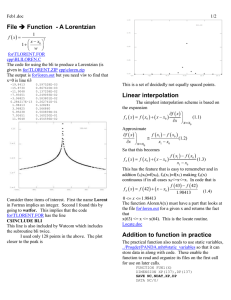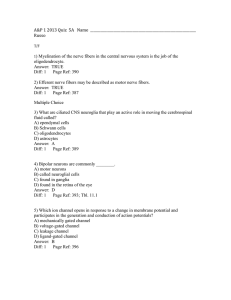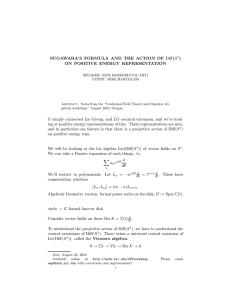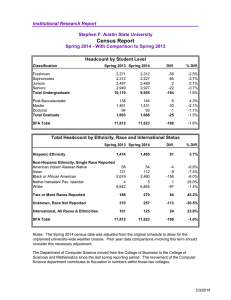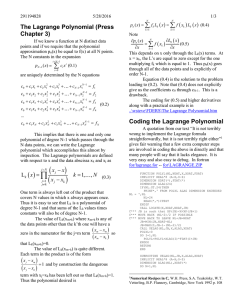Lagrange interpolation 1. ... 1 Finding the region with the
advertisement
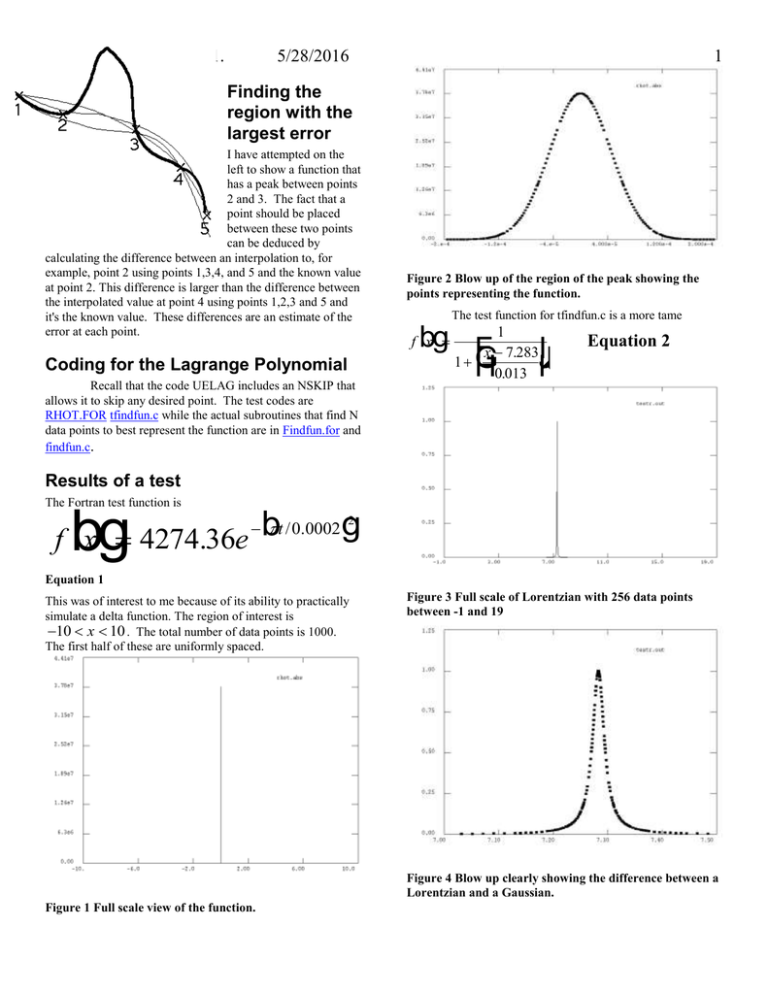
Lagrange interpolation 1.
5/28/2016
1
Finding the
region with the
largest error
I have attempted on the
left to show a function that
has a peak between points
2 and 3. The fact that a
point should be placed
between these two points
can be deduced by
calculating the difference between an interpolation to, for
example, point 2 using points 1,3,4, and 5 and the known value
at point 2. This difference is larger than the difference between
the interpolated value at point 4 using points 1,2,3 and 5 and
it's the known value. These differences are an estimate of the
error at each point.
Coding for the Lagrange Polynomial
Recall that the code UELAG includes an NSKIP that
allows it to skip any desired point. The test codes are
RHOT.FOR tfindfun.c while the actual subroutines that find N
data points to best represent the function are in Findfun.for and
findfun.c.
Figure 2 Blow up of the region of the peak showing the
points representing the function.
The test function for tfindfun.c is a more tame
bg Fx 1 7.283I
1 G
H0.013 J
K
f x
Equation 2
Results of a test
The Fortran test function is
bg
f x 4274.36e b
t / 0.0002
g
2
Equation 1
This was of interest to me because of its ability to practically
simulate a delta function. The region of interest is
10 x 10 . The total number of data points is 1000.
The first half of these are uniformly spaced.
Figure 3 Full scale of Lorentzian with 256 data points
between -1 and 19
Figure 4 Blow up clearly showing the difference between a
Lorentzian and a Gaussian.
Figure 1 Full scale view of the function.
Lagrange interpolation 1.
Fortran Coding Details
5/28/2016
main program
CF90 IF(IERR.NE.0)STOP 'Not enough storage for
XDAT,FDAT'
2
Then finally there is the call to finfun.
CALL FINFUN(P1,BEGT,ENDT,XDAT,FDAT,NDAT)
The test code RHOT.FOR begins with
IMPLICIT REAL*8 (A-H,O-Z)
COMPLEX*16 P1
EXTERNAL P1
C FOLOWING 4 LINES ARE FOR F77
PARAMETER(NDATM=5000)
DIMENSION XDAT(NDATM)
COMPLEX*16 FDAT(NDATM)
COMMON/PASS/DIFF(NDATM)
DIMENSION RREAL(5),IRINT(5)
CHARACTER*128 RCHAR(2)
CHARACTER*128 NAME
CHARACTER*1 F90
C FOLLOWING 2 LINES ARE F90 SPECIFIC
CF90 REAL*8 XDAT[ALLOCATABLE](:)
CF90 COMPLEX*16 FDAT[ALLOCATABLE](:)
DATA F90/'N'/
NINT=1
NREAL=2
NCHAR=1
PRINT*,'BEG END NDAT '
READ(*,*)BEGT,ENDT,NDAT
Note
1. P1 is complex. In physics we routinely use complex
numbers. The EXTERNAL statement tells the compiler
to look for a function outside the main code. This is
Fortran's of passing the name of a function as an
argument.
2. There are 4 lines specific to Fortran 77.
The first is a parameter ndat=5000. This is an attempt
to be able to test the code without using a lot of memory
or introducing errors by forgetting to change all of the
dimensions.
The fourth line is a common/pass/. This is an attempt
to put all of the data storage into the main code where it is
effected by the parameter statement without actually
passing the data. In Fortran 90 or C this is created in the
subroutine itself. The problem with this external pass is
that there is a very real probability of re-using the name or
the space, thereby causing a very hard to locate bug. An
alternative is to use a parameter statement in the
subroutine, but that means changing possibly different
parameter names in multiple program segments long after
the logic has been forgotten.
3. Then there are two commented out lines that refer to
Fortran 90. This is why Fortran will survive; it is a
concept adopted from C.
4. Finally there is a print telling the user what to input.
Actually the next 5 lines that are commented out are of
interest. These allow input from the command line
Progdet\GINPUT.htm
C
ITEST=IPRARG(RREAL,NREAL,IRINT,NINT,RCHAR,NCHAR)
CIF(ITEST.NE.0)STOP 'Unable to input data in IPRARG'
C
NDAT=IRINT(1)
IF(F90.EQ.'N'.AND.NDAT.GT.NDATM)STOP ' NDAT > NDATM
STOPPING'
C
BEGT=RREAL(1)
C
ENDT=RREAL(2)
Next come the Fortran 90 implementations of the C allocate
routines.Progdet\calloc.htm
C FOLLOWING 2 LINES ARE F90 SPECIFIC
CF90 ALLOCATE (XDAT(NDAT),FDAT(NDAT),STAT=IERR)
There are numerous lines trying to figure out where to write
the data and a few defining the function that can be read from
the file itself.
Findfun
FUNCTION FMPOLY(XDAT,FDAT,NDAT,NL,NP,NDATP)
C NL is number of data points including the skipped
one
C XDAT(NP)is the data point to examine. i.e. skip NP
IMPLICIT REAL*8 (A-H,O-Z)
COMPLEX*16 FDAT(NDAT)
PARAMETER (NLAG=12)
DIMENSION XDAT(NDAT),ALAG(NLAG)
IF(NL.GT.NLAG)THEN
PRINT*,' EXCEEDED ALAG DIMENSION IN DIFF'
STOP
ENDIF
IF(NP.GT.NDAT.OR.NDATP.GT.NDAT)THEN
PRINT*,' OUT OF DATA BOUNDS IN DIFF'
STOP
ENDIF
MBEG=MAX0(0,NP-1-NL/2)
MBEG=MIN0(NDATP-NL,MBEG)
Note that the interpolation is centered about np, locate is not
used.
CALL UELAG(NL,XDAT(NP),MBEG,NP,ALAG,XDAT)
POLYL=0
DO I=1,NL
POLYL=POLYL+ALAG(I)*ABS(FDAT(I+MBEG))
ENDDO
FMPOLY=ABS(ABS(FDAT(NP))-POLYL)
IF(FMPOLY.EQ.0)FMPOLY=1D-37
RETURN
END
The findfun routine itself is
SUBROUTINE FINFUN(FUN,BEGR,ENDR,XDAT,FDAT,NDAT)
C *** FIRST EVALUATE THE FUNCTION AT N DATA POINTS
IMPLICIT REAL*8 (A-H,O-Z)
COMPLEX*16 FDAT(NDAT),FUN
C FOLLOWING 2 LINES FOR F77, SHOULD BE REPLACED BY
F90 PARTS
PARAMETER (NMAX=5000)
COMMON/PASS/DIFF(NMAX)
C FOLLOWING IS USEFUL IN F90
CF90 REAL*8 DIFF[ALLOCATABLE](:)
The above plus the 3rd and 4th lines below are the
allocation lines for the diff data which really should be specific
to this routine.
DIMENSION XDAT(NDAT)
C FOLLOWING 2 LINES ARE USEFUL IN F90
CF90 ALLOCATE (DIFF(NDAT),STAT=IERR)
CF90 IF(IERR.NE.0)STOP 'Finfun Not enough storage
for diff'
NDBEG=NDAT/2
H=(ENDR-BEGR)/(NDBEG-1)
DO I=1,NDBEG
XDAT(I)=BEGR+H*(I-1)
FDAT(I)=FUN(XDAT(I))
ENDDO
Half of the points are used in an equal mesh. One needs a
general search before a specific one.
DO I=1,NDBEG
DIFF(I)=FMPOLY(XDAT,FDAT,NDAT,5,I,NDBEG)
IF(I.EQ.1)THEN
DIFF(I)=(XDAT(2)-XDAT(1))*DIFF(I)
ELSEIF(I.EQ.NDBEG)THEN
Lagrange interpolation 1.
5/28/2016
DIFF(I)=(XDAT(NDBEG)-XDAT(NDBEG-
1))*DIFF(I)
ELSE
DIFF(I)=(XDAT(I+1)-XDAT(I))*DIFF(I)
ENDIF
ENDDO
Note that the size of the region enters into the determination of
the relative error. It is at this point that you would return if
you were simply checking for typo's in manually typed data.
52
NDTOT=NDBEG
AMERR=0
DO I=1,NDTOT
IF(ABS(DIFF(I)).GE.AMERR)THEN
AMERR=ABS(DIFF(I))
IMAX=I
ENDIF
ENDDO
The reason for finding the diff's was quite simply to find
IMAX the location of the largest.
IF(IMAX.EQ.1)THEN
DL=0
ELSE
DL=XDAT(IMAX)-XDAT(IMAX-1) ENDIF
IF(IMAX.EQ.NDTOT)THEN
DR=0
ELSE
DR=XDAT(IMAX+1)-XDAT(IMAX)
ENDIF
IF(DL.GT.DR)THEN
XNEW=.5D0*(XDAT(IMAX-1)+XDAT(IMAX))
ELSE
XNEW=.5D0*(XDAT(IMAX)+XDAT(IMAX+1))
IMAX=IMAX+1
ENDIF
Note that XNEW is put on the side of IMAX which has the
largest delta x.
C move the stack up
DO I=NDTOT,IMAX,-1
XDAT(I+1)=XDAT(I)
FDAT(I+1)=FDAT(I)
DIFF(I+1)=DIFF(I)
ENDDO
Note that moving the stack requires a -1 increment to avoid
overwriting values.
NDTOT=NDTOT+1
XDAT(IMAX)=XNEW
FDAT(IMAX)=FUN(XDAT(IMAX))
N1=MAX(1,IMAX-5)
N2=MIN(NDTOT,IMAX+5)
DO I=N1,N2
DIFF(I)=FMPOLY(XDAT,FDAT,NDAT,5,I,NDTOT)
IF(I.EQ.1)THEN
DIFF(I)=(XDAT(2)-XDAT(1))*DIFF(I)
ELSEIF(I.EQ.NDTOT)THEN
DIFF(I)=(XDAT(NDTOT)-XDAT(NDTOT1))*DIFF(I)
ELSE
DIFF(I)=(XDAT(I+1)-XDAT(I))*DIFF(I)
ENDIF
ENDDO
Only a few of the differences need to be redefined.
IF(NDTOT.LT.NDAT)GOTO 52
RETURN
END
C programming details
main file
#include <stdlib.h>
#include <stdio.h>
#include <math.h>
#include <string.h>
struct bcmpl {double real;double aimag;};
3
There is no complex in ansi C. I defined bcmpl for
the minimum complex concept. The idea was to use a name
that would not interfere with later use of actual complex. A
strength of ansi C is that it is almost always available. I
believe that a little hand coding of some complex functions is
worthwhile to keep the routines always useable.
struct bcmpl floren(double x)
The function is defined as the structure. Note that so
is ret_val below.
{double ratio,x0=7.283,w0=0.013;
struct bcmpl ret_val;
ratio = (x-x0)/w0;
ret_val.real = 1/(1+ratio*ratio);
ret_val.aimag = 0;
return ret_val;}
void main(void)
{double xdat[1000],fdatr[1000],fdati[1000];
double begt,endt,tabs;
int ndat,i;
char name[80],oname[80];
FILE *outr,*outi,*outabs;
printf("enter begt endt ndat\n");
scanf(" %lg %lg %d",&begt,&endt,&ndat);
printf("enter the root file name\n");
scanf("%s",&name);
strcpy(oname,name);
strcat(oname,"r.out");
outr = fopen(oname, "wt");
printf("real data is in %s\n",oname);
…
finfun(floren,begt,endt,xdat,fdatr,fdati,ndat);
…
void finfun(struct bcmpl(*fun)(double),double
begr,double endr,
double xdat[],double fdatr[],double fdati[],int
ndat)
Note the C method for passing the name of a
function.EXTERNAL.htm
…
{double *diff;
double h,amerr,dl,dr,xnew;
struct bcmpl temp;
int i,imax,ndtot,ndbeg,nl=5,none,n2;
diff = (double *) calloc(ndat,
Progdet\calloc.htm
sizeof(double));
…
temp=(*fun)(xdat[i]);
fdatr[i]=temp.real;
fdati[i]=temp.aimag;}
The actual call to the function.
Assignment
W rite a code to find
F
bx 35. gIJ
G
H 2 K
F bx 3.7gIJ 10 expF
bx 3.7gIJ
12 expG
G
H 2 K H 0.02 K
bg
f x 10 exp
How small does the third 10 need to be before this peak
cannot be found?
